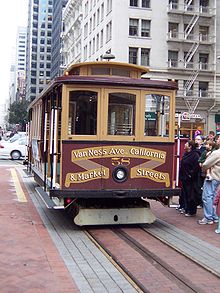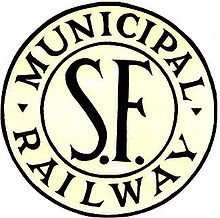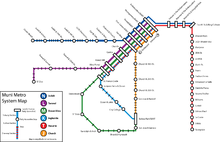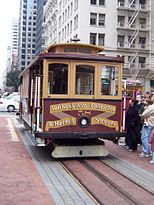- San Francisco Municipal Railway
-
San Francisco Municipal Railway 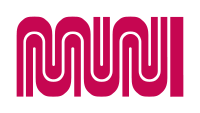
Info Owner City and County of San Francisco Locale San Francisco Transit type Bus, trolleybus, light rail, streetcar, cable cars Number of lines 82 Daily ridership 686,000 (2006) Chief executive Edward D. Reiskin, Executive Director/CEO, SFMTA Headquarters One South Van Ness Avenue, Seventh Floor Operation Began operation 1912 Operator(s) San Francisco Municipal Transportation Agency (SFMTA) Technical Track gauge 4 ft 8 1⁄2 in (1,435 mm) (light rail)
3 ft 6 in (1,067 mm) (cable cars)Minimum radius of curvature 43 ft (13.106 m) [1] Average speed 7 mph (11 km/h)[2] Top speed varies The San Francisco Municipal Railway (SF Muni or Muni) is the public transit system for the city and county of San Francisco, California. In 2006, it served 46.7 square miles (121 km2) with an operating budget of about $700 million.[3] In terms of ridership, Muni is the seventh largest transit system in the United States, with 210,848,310 rides in 2006[4] and the second largest in California behind Metro in Los Angeles. With a fleet average of 7-8.1 mph, it is also the slowest major transit system in America.[5]
Muni is an integral part of public transit in the city of San Francisco, operating 365 days a year and connecting with regional transportation services, such as Bay Area Rapid Transit (BART), SamTrans, and AC Transit. Its network consists of 54 bus lines, 17 trolley bus lines, 7 light rail lines that operate above ground and in the City's lone subway tube (called Muni Metro), 3 cable car lines, and a heritage streetcar line known as the F Market & Wharves. Many weekday riders are commuters, as the daytime weekday population in San Francisco exceeds its normal residential population. Muni shares four metro stations with BART, which can lead to confusion amongst visitors. Travelers can connect to San Francisco International Airport and Oakland International Airport via BART.
Several routes operate 24 hours a day, such as the 38 Geary. Muni routes operate on a schedule, and the frequency of service varies at various times of day. Trip planning has been made easier by the implementation of GPS monitoring for most routes through NextBus, allowing for easier predictions of arrival times.
Contents
Operations
Most bus lines are scheduled to operate every five to fifteen minutes during peak hours, every five to twenty minutes middays, about every ten to twenty minutes from 9 pm to midnight, and roughly every half hour for the late night "owl" routes. On weekends, most Muni bus lines are scheduled to run every ten to twenty minutes. However, complaints of unreliability, especially on less-often-served lines and older (pre-battery backup) trolleybus lines, are a system-wide problem. A February 20, 2007, article in the San Francisco Chronicle noted that Muni was not able to meet its modest goal of 85% voter-demanded on-time service.[6]
All Muni lines run roughly inside San Francisco city limits, with the exception of several lines that serve some locations in the northern part of neighboring Daly City, and the 76 Marin Headlands line to the Marin Headlands area on Sundays and various holidays. Most intercity connections are provided by BART and Caltrain heavy rail, AC Transit buses at the Transbay Terminal and Golden Gate Transit and SamTrans downtown.
Bus and car stops throughout the city vary from Metro stations with raised platforms in the subway and at the more heavily used surface stops, to small shelters to signposts to simply a yellow stripe on a utility pole or on the road surface. 70% of stops are spaced closer than recommended range of 800–1000 feet apart.[7]
Name and logo
Muni is short for the "Municipal" in "San Francisco Municipal Railway" and is not an acronym; thus, when it is written in plain text, only Muni (not MUNI) is correct. However, many San Franciscans, including some of those who work for Muni, write it MUNI. The Muni metro is often called "the train" or "the streetcar". Most San Francisco natives reference 'Muni' when speaking about the system (Metro & buses) in general.
The F Market & Wharves line is referred to by Muni as a "historic streetcar line" rather than as a "heritage railway".
Muni's logo is a stylized, trademarked "worm" version of the word "MUNI".[8] This logo was designed by San Francisco-based graphic designer Walter Landor in the mid-1970s.[9]
Route names
Main article: List of San Francisco Municipal Railway linesAll Muni routes, except the cable cars, have two parts to the name, and are most often referred to by both, for example, the "1 California". The word(s) on the end generally refer to the street encompassing the plurality of the line. This does not mean that the line runs solely on that street (e.g., the 1 California runs on Sacramento and Clay Streets east of Pacific Heights). Bus and trolleybus lines have number designations, rail lines have letters and the three cable car lines are typically referred to by name only (Powell-Mason, Powell-Hyde and California). However, Muni maps abbreviate the cable car route names to PM, PH and C, and they are given route numbers 59, 60 and 61, respectively, for use within Muni operations.
Fares
Fares are $2.00 for adults and $0.75 for seniors over 65, youth aged 5–17, and disabled persons. Proof-of-payment (POP) is handled through a transfer slip, either a piece of newsprint-like paper, torn to indicate expiration time (buses and streetcar) or machine-printed on thicker tag stock at subway stations and a few outdoor stops such as the one at San Francisco State University, any of which can be checked by fare inspectors. These transfer receipts allow travel on almost any Muni vehicle for at least 90 minutes but no more than 2 hours from the time of issue. The exception to this is for cable car lines which require a $6.00 one-way fare with no transfers unless the rider has a Fast Pass. This monthly pass is $62 for adults ($72 with BART functionality within city limits), $30 for low-income residents ("Life Line Pass"),[10] or $20 for youth and seniors, as of January 2010.[11] Persons with disabilities who have obtained a Regional Transit Connection discount card may purchase a $20 disabled monthly sticker. Fast Passes are valid on all Muni lines—including cable cars—and the $72 adult Fast Pass allows BART transit entirely within San Francisco (between Embarcadero and Balboa Park). Other passes and stickers are valid on all Muni lines, including cable cars, but not on BART (with the exception of BART-Plus[12] ticket types).
Cable car fare is $6 per trip, with no transfers issued or accepted. "Passports" are folding scratch-off passes that can be purchased by mail, or at various places throughout the city; they are good on all regular-service lines without surcharge, including cable cars, and cost $14 for a 1-day pass, $21 for a 3-day pass, or $27 for a 7-day pass, as of July 2011.[11]
Special round-trip fares are set for buses going to Candlestick Park during football games. They are $12 for adults, $9 for children and seniors, and $7 for anyone with a pass.[11] Riders are given a special pass once they pay the fare, which they can then use on the return trip from the park.[13]
Muni has implemented a dual-mode smart card payment system known as Clipper (formerly TransLink). The transponders have been in use since at least 2004[14] and are currently in the process of phasing out paper monthly passes in favor of passes loaded onto Clipper cards. TransLink was expected to be rolled out in summer 2008 on Muni, but this expansion has suffered delays. BART, Caltrain, and Golden Gate Transit now also utilize the Clipper system.[15]
Year Fare Price of adult monthly pass Cable car fare 2011 $2.00[16] $72 with BART access, $62 without BART access[17] $6.00[18] 2010 Usually $2.00, occasionally $2.25 for a single-use Clipper Card[19] $70 with BART access, $60 without BART access[20] $5.00[21] 2009 $2.00[22][23][24] $55[24][25] $5.00 2008 $1.50[26] $45[26] $5.00[26] 2006 $1.50[26][27] $45[26] $5.00[26][27] 2005 $1.25 increases to $1.50[26] $45[26][28] $5.00[26][29] 2003 $1.00 increases to $1.25[26][28] $45[26][28] $3.00[30] increases to $5.00[26] 2002 $1.00[26] $35[26] $2.00[26][31] 1999 $1.00[26][32] $35[26][28] $2.00[26] 1998 $1.00[26] $35[26][33][34] $2.00[26] 1993 $1.00[26][35] $35/$45[26] $2.00 each way[26][29] 1992 $0.85[36] increases to $1.00[26] $32[26] $3.00 round-trip[26][29] 1991 $0.85[26] $30[26] $2.00[26] 1988 $0.75 increases to $0.85[26][37] $28[26] $2.00[26][29] or $2.50[37] 1987 $0.75[38] $25[26] $1.50[26] 1986 $0.60 increases to $0.75[26][39] $23[26] $1.00 increases to $1.50[26][29] 1985 $0.60[40] $24[26] $1.00[26] 1984 $0.60[26] $20[26] $1.00[26] 1982 $0.50 increases to $0.60[26][41] $16[41] increases to $24[26] $1.00[26][29] 1981 $0.50[26] $16[26] $0.50[42] 1980 $0.25 increases to $0.50[26] $16[26] $0.25[26] 1979 $0.25[43] $11[43] $0.30[26] 1976 $0.25[44] $11[44] $0.25[45] 1975 $0.25[46] $11[26] $0.25[26] 1974 $0.25[26] Monthly passes introduced at $11[26] $0.25[26] 1970 $0.20 increases to $0.25[26][47] $0.25[26] 1969 $0.15[26][47] increases to $0.20[26][48] $0.25[26] 1961 $0.15[49] $0.05[26] 1952 $0.10 increases to $0.15[26][48] or $0.10[50] $0.05[26] or $0.10[50] 1951 $0.10[48] $0.05[26] 1950 $0.10[51] $0.05[26] 1949 $0.10[52][53] $0.05[26] 1947 $0.10 per ride, or $0.25 for three tokens[54] $0.05[26] 1946 $0.07 increases to $0.10[26] $0.05[26] or $0.07[55] 1945 $0.07[50] $0.05[26] or $0.07[50] 1944 $0.05 increases to $0.07[26] $0.05[26] or $0.07[55] 1937 $0.05[56] $0.05[26] 1932 $0.05[57] $0.05[26] 1912 $0.05[26] $0.05[26] Special service
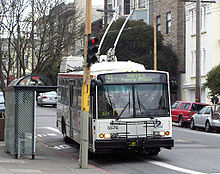 A trolleybus on the 21-Hayes line
A trolleybus on the 21-Hayes line
Muni operates 15 express lines, 5 Limited lines, and 12 Owl lines, which run between 1 am and 5 am. During sporting events, additional lines go to Candlestick Park.
Express lines only run during peak hours (with the sole exception of the 8X Bayshore Express); during mornings they run towards downtown (the Financial District) and during the evening they run away from downtown. All express lines have an "X", "AX", or "BX" following the line's number. Some lines are divided into A and B Expresses. The B Express line is shorter and has stops that are closer to downtown, while the A Express makes stops further away from downtown and will make few or no stops in the area where the B Express stops.
Limited lines also provide fast service along their routes. They make fewer stops than the standard line to achieve faster travel, but the stops are interspersed at greater intervals along the entire line. Express buses make frequent local stops near the origin and destination, but not in the middle. Limited buses take the same route as the regular line, while Express buses take a bypass route. All limited-stop lines have an "L" following the line's number.
Statistics
Muni operates about 1,000 vehicles: diesel, electric, and hybrid electric transit buses, light rail vehicles, streetcars, historic streetcars, and cable cars. Many buses are diesel-powered, but more than 300 are zero emissions trolleybuses powered by overhead electrical wires. The electricity to run all of Muni's trolleybuses and streetcars comes from the Hetch Hetchy Reservoir in Yosemite National Park.[58]
In 2006, Muni purchased 86 hybrid electric transit buses from Orion Bus Industries that are diesel-fueled but feature lower emissions and 19% reduced fuel consumption.[59]
All Muni lines except for cable cars are wheelchair accessible. All bus lines have bicycle racks, but streetcars and cable cars do not.
The longest Muni line is the 24.1-mile (38.8 km) 91 Owl, a nighttime-only route that blends several other routes together, while the longest daytime route is the 17.4-mile (28.0 km) 29 Sunset. The shortest route is the 88 BART Shuttle at 1.4 miles (2.3 km). The steepest grade climbed by Muni vehicle is 23.1% by a diesel bus on the 67 Bernal Heights line, 22.8% by a trolleybus on the 24 Divisadero line, and 21% by a cable car on the Powell-Hyde line.[60]
The busiest Muni bus line is the 38 Geary, which travels 6.5 miles (10.5 km) in the east–west direction along the Geary corridor, and has an average speed of only 8 miles per hour (13 km/h).[61] Door to door, it takes over 50 minutes to traverse the distance from the Richmond District to the Transbay Terminal when operating on schedule.[62]
At Powell and Market Streets and California and Market Streets, three types of rail gauges come within a few hundred feet of each other: Bay Area Rapid Transit's 5 ft 6 in (1,676 mm) broad gauge (which is underground in the lower level of the tunnels), Muni Metro's 4 ft 8 1⁄2 in (1,435 mm) Standard gauge (also underground in the upper level of the tunnels), and the San Francisco cable car system's 3 ft 6 in (1,067 mm) narrow gauge (at street level a few hundred feet away to the north of Market Street in both cases). The F Market heritage railway is also present here, at street level on Market Street. The rail lines, however, do not physically intersect.
The F Market and Wharves line uses the same standard gauge as the Muni Metro, and in fact uses the J Church tracks to travel between its regular route and the storage facility near Balboa Park Station.
Governance
Main article: San Francisco Municipal Transportation AgencySince the passage of Proposition E in November 1999, Muni has been part of the San Francisco Municipal Transportation Agency (SFMTA), a semi-independent city agency created by that ballot measure. The agency, into which Muni, the Department of Parking and Traffic, and the Taxicab Commission were merged, is governed by a seven-member Board of Directors appointed by the Mayor and confirmed by the Board of Supervisors.
The executive director and CEO of the SFMTA since August 15, 2011 has been Edward D. Reiskin, who previously headed the San Francisco Department of Public Works. He replaced Debra A. Johnson, the acting executive director and CEO who replaced Nathaniel P. Ford, Sr. upon his resignation.[63][64]
History
An F Market and Wharves heritage streetcar at the Ferry Building.
Early years
Muni has its origins in the period following the 1906 San Francisco earthquake. Until then the city had been served by a number of commercial horsecar, cable car and electric streetcar operators. Many of these had been amalgamated into the United Railroads of San Francisco (URR) company. In 1909, voters approved a municipal rail line down Geary. Three years later in 1912, the city declined to renew the franchise that bestowed cable car operator Geary Street, Park & Ocean Railway the privilege of operating on Geary Street, and converted the line into a municipal electric streetcar line,[65][66] the first line of Muni. In 1912, the average speed of the city's public transit was approximately 8.5 miles per hour[67] -- slightly faster than the average speed of 8.1 in 2007.[68]
Muni soon started on a large building program. On December 29, 1914, the new Stockton Street Tunnel under Nob Hill opened, allowing streetcars from downtown to go to North Beach and the new Marina District. On February 3, 1918, the Twin Peaks Tunnel opened, making the southwestern quarter of the city available for development. On October 21, 1928, the Sunset Tunnel opened, bringing the N Judah streetcar line to the Sunset District. These improvements plunged Muni into direct competition with the URR on the entire length of Market Street. The two operators each operated their own pair of rail tracks down that thoroughfare, which came to be known as the "roar of the four".[69]
1940s: The first trolleybuses
In 1941, Muni introduced its first trolleybus line, the R-Howard line. By 1944 the Market Street Railway Company, successor to the URR, was in financial difficulties. Thus, at 5 am on September 29, 1944, Muni acquired its commercial competitor. Along with the routes and equipment, Muni adopted its competitor's more expensive seven-cent fare.[70] Following national trends, Muni replaced most of its rail lines with trolleybus service in the succeeding decades. A few lines with dedicated right-of-ways (including those serving the Twin Peaks and Sunset tunnels) continued as rail lines running 1930's-era PCC streetcars into the 1970s. These lines became the foundation of the Muni Metro.
1970s and '80s: Construction and reorganization
In the 1950s and 60's, the neighboring BART system had been conceived on a grandiose level (described as one of the "great planning disasters" of the 20th century[71] ), operating express trains through San Francisco, and local service within San Francisco. Because it was assumed BART would provide local rail service, investment in Muni infrastructure failed to keep pace with major urban redevelopment projects. For example, BART was intended to provide Richmond district and Western Addition service as part of its Golden Gate Bridge/Marin line. This leaves a legacy of the inadequate 38-Geary bus serving these neighborhoods.
Construction on BART's Market street tunnel started in 1967,[72] with two decks tracks - the upper intended to provide local service. Major cost overruns in the BART project forced the state legislature to rescue the project in 1969: curtailing local service in San Francisco and converting the partially-constructed stations into the basis of a new light-rail Metro to connect the downtown stations to the Twin Peaks Tunnel and continuing a subway to St. Francis Circle. Construction on the metro began in 1970, but the design suffered from further cuts and design changes throughout the 1970s. The Muni metro finally opened in July, 1980, but the many design compromises and piecemeal planning lead to long-term operational challenges and inefficiencies.
In 1970 Muni also suffered a severe diesel bus crisis. In 1982, the cable car system was shut down for 18 months for rebuilding, and there were massive line reorganizations due to diesel bus issues.
In 1983, Muni temporarily ran streetcars down Market Street as part of the San Francisco Historic Trolley Festival. The service became so popular over the festival was repeated for several years following. Anticipating permanent streetcar service on Market, Muni began rehabilitating tracks in 1987, a process that culminated in the opening of the F line in 1995.
1990s: the "Muni Meltdown"
During the late 1990s, with aging equipment and poor management, Muni developed a reputation for poor and erratic service. In 1996 a group called Rescue Muni representing transit riders formed to organize concerns and press for change. A controversial aspect to their work was to endorse riders using emergency levers to open doors for trains stalled in tunnels and near designated stops. In an effort to improve service, Muni began to replace its troublesome fleet of Boeing-Vertol streetcars with newer Italian Breda streetcars. In 1998, San Francisco residents witnessed a protracted malfunction of Muni Metro during the switch to automatic train control, culminating in an event that is known as the Muni Meltdown. The decade old fleet of New Flyer trolleybuses were mostly replaced with ETI Skoda[73] trolleybuses in the early 2000s. Likewise, the diesel bus fleet saw an infusion of 45 new NABI buses from AC Transit in 1999.
Meanwhile, the F line was reintroduced in 1995 as a heritage railway. Initially designed as a temporary tourist attraction to make up for the closure of the cable car lines, the F has become a permanent fixture.
2000s
On October 8, 2007, SFMTA's notable cable car signs were awarded the AdWheel Award as the best in print promotion by the American Public Transportation Association. Nathaniel Ford, executive director of Muni, said that the "marketing group has done an outstanding job making the key boarding areas more attractive and inviting for residents and our guests."[74]
On November 15, 2007, city officials announced that they were looking into the possibility of adding double-decker buses to the Muni fleet, which would be operating mostly on the 38 Geary and the 14 Mission routes. The test period started on December 12, 2007, and ended on January 8, 2008.[75][76]
On December 1, 2007, Mayor Gavin Newsom announced that the entire city fleet, including all of Muni buses, are henceforth powered with biodiesel, a combination of 80% petroleum diesel fuel and 20% biofuel, to reduce carbon emissions.[77] Muni's current hybrid bus fleet currently runs on biodiesel.[78][79]
On July 17, 2009, a Muni LRV rear-ended another at West Portal Station. That accident injured 50 people.[80]
On December 5, 2009, the Muni system underwent its most extensive changes in over 30 years, in an attempt by the SFMTA to reduce its budget shortfall. This involved changes to over 60 percent of its bus and light rail routes, including the elimination of six bus routes. Changes included reduced frequency of service, shortened or altered routes, and earlier termination of service, although a few of the busiest lines, such as the 38 Geary, saw service increases.[81]
2010s
On February 26, 2010, the SFMTA board, which oversees Muni operations, voted for Muni to undergo further extensive changes in a further attempt to reduce its budget shortfall.[82]
System expansion
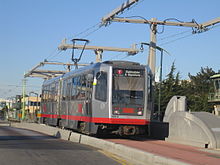 A light rail vehicle on the T Third Street line. The T line, the sixth Muni Metro line, opened on April 7, 2007.
A light rail vehicle on the T Third Street line. The T line, the sixth Muni Metro line, opened on April 7, 2007.
Construction on a sixth light rail line from Caltrain Depot in Mission Bay to Visitacion Valley and Bayview/Hunters Point was completed in December 2006. The new line, named the T Third Street, consists of 19 new high-platform stations at street-level, including at least one within walking distance of Candlestick Park.[83][84]
A further underground expansion for the T line is being planned. Dubbed the Central Subway, four proposed new underground stations at Moscone Center, Market and Stockton Streets, Union Square, and Chinatown are being studied for a possible target date of 2016. A future extension into North Beach and Fisherman's Wharf or to the Marina District and The Presidio may be built in a third phase. This project is expected to cost about $1.4 billion.[85] A critical problem with the proposed subway is that the stations will be much narrower and shorter in comparison to existing Muni Metro stations on Market Street; ridership projections reveal that the line will run at near capacity from the start of operations with little or no ability to increase capacity. Some activists have criticized these long-term plans as catering to the needs of visitors at the expense of city residents, asserting that Muni's resources would be better spent on a seventh light rail line running along (or under) Geary Boulevard into the densely populated Richmond District. Currently, a bus rapid transit ("BRT") line is being planned for Geary Boulevard, possibly as a precursor to a light rail line.
Expected smaller changes to service include rerouting the 22-Fillmore and extending either the 30-Stockton or 45-Union-Stockton into Mission Bay when the area becomes developed, and a new E Embarcadero historic streetcar line is expected to begin operation along the Embarcadero from Fisherman's Wharf to the Caltrain station at 4th and King Streets, with a possible future extension into Mission Bay.
Additionally, there are plans to expand trolleybus service in several parts of the city. Several extensions to existing trolleybus lines are planned, including 14-Mission service to the Daly City BART station, 6-Parnassus service to West Portal Station, 33-Stanyan service across Potrero Hill to Third Street, 45-Union-Stockton service to the Letterman Digital Arts Center in the Presidio and 24-Divisadero service into the former Hunters Point shipyard. Other expansion plans include electrification of some diesel bus lines, with the most likely lines for conversion being the 9-San Bruno, 10-Townsend and 47-Van Ness. Electrification of the 10-Townsend line would likely be joined by an extension of the line across Potrero Hill to San Francisco General Hospital. Other lines that may be electrified are the 2-Clement, 27-Bryant, 43-Masonic and 71-Haight-Noriega.[86][87][88][89][90][91]
However, the average speed of Muni vehicles has been slowly declining over the years due to increasing vehicular congestion and is now merely 8 miles (13 km) per hour.[92] In response, Muni has launched plans to make its transit vehicles move faster through the city. The Transit Effectiveness Project was launched in May 2006 to take a comprehensive look at the entire Muni system and to see where service can be improved or streamlined to provide faster and more reliable service. Twenty-five years have passed since the last comprehensive review, and travel patterns have changed, traffic congestion has increased, operating costs have risen and on-time performance has dropped since then. Automatic passenger counters will help to provide an accurate picture of where riders get on and off. In addition, bus rapid transit is currently being proposed on the Geary and Van Ness corridors.[93][94]
Bibliography
- Perles, Anthony, with John McKane, Tom Matoff, and Peter Straus, The People's Railway: The History of the Municipal Railway in San Francisco. Glendale: Interurban Press, 1981. ISBN 0916374424. A detailed, illustrated history of Muni from its inception through 1980. Currently out of print, but used copies are frequently available through booksellers specializing in transportation and railroads.
See also
- Key System
- Market Street Railway Company
- San Francisco cable car system
- Trolleybuses in San Francisco
References
- ^ Transportation Research Board (1995). TCRP Report 2: Applicability of Low-Floor Light Rail Vehicles in North America. National Research Council. p. 56. http://onlinepubs.trb.org/Onlinepubs/tcrp/tcrp_rpt_02.pdf. Retrieved 2009-05-06.
- ^ Gordon, Rachel (December 5, 2007). "Muni's on-time rate for quarter rises to 72.7%". The San Francisco Chronicle. http://articles.sfgate.com/2007-12-05/bay-area/17273157_1_on-time-rate-on-time-performance-newsom.
- ^ Bose, Sonali. "FY 2006-2007 Third Quarter Financial Results and Year-End Projection" (PDF). San Francisco Metropolitan Transportation Agency. http://www.sfmta.com/cms/rbudget/documents/FY2006-073rdqtrFinancialResultsyearendprojection.pdf. Retrieved 2009-05-06.
- ^ "Fiscal Year 2008 Short Range Transit Plan: Chapter 4" (PDF). San Francisco Metropolitan Transportation Agency. http://www.sfmta.com/cms/rsrtp/documents/09Chapter4-CurrentServiceaccessible-fy08PublicDraftforMTAB10-2.pdf. Retrieved 2009-05-06.
- ^ Eskenazi, Joe. "The Muni Death Spiral". San Francisco Weekly. http://www.sfweekly.com/2010-04-14/news/the-muni-death-spiral/.
- ^ Gordon, Rachel. "Muni misses on-time goal". San Francisco Chronicle. http://articles.sfgate.com/2007-12-05/bay-area/17273157_1_on-time-rate-on-time-performance-newsom. Retrieved October 14, 2007.
- ^ Hamilton, John. "Interview with SFMTA Officials". Making Muni Faster and More Reliable Through Bus Stop Consolidation (Film). Streetfilms. http://www.streetfilms.org/making-muni-faster-and-more-reliable-through-bus-stop-consolidation/. Retrieved 2011-04-04.
- ^ "Muni Logo". Metropolitan Transportation Commission. http://transit.511.org/providers/logos/SF_930200335551.png. Retrieved June 13, 2006.
- ^ Fernandez, Elizabeth (April 16, 1996). "Walter Landor, 81, designer". San Francisco Chronicle. http://www.sfgate.com/cgi-bin/article.cgi?file=/examiner/archive/1995/06/11/METRO11293.dtl. Retrieved January 12, 2009.
- ^ Sherburn-Zimmer, Sarah (2007). "A Low-Income Bus Pass that Most Don't Use". BeyondChron.org. http://www.beyondchron.org/articles/A_Low_Income_Bus_Pass_that_Most_Don_t_Use_4531.html. Retrieved May 30, 2007.
- ^ a b c "May 2010 fare increases". Sfmta.com. http://www.sfmta.com/cms/malerts/January2010Munifareincreases.htm. Retrieved 2011-06-20.
- ^ "BART Plus Tickets". BART. http://www.bart.gov/tickets/plus.aspx. Retrieved January 1, 2007.
- ^ "Candlestick Park and other Special Event Fares". San Francisco Municipal Railway. http://www.sfmta.com/cms/mfares/fareinfo.htm#special. Retrieved June 12, 2006.
- ^ "Proof of Payment & Always Ask for a Transfer". San Francisco Metropolitan Transportation Agency. 2004. http://www.sfmta.com/cms/mfares/pop.htm. Retrieved November 13, 2007.
- ^ "Where To Use TransLink". TransLink. https://www.clippercard.com/ClipperWeb/useTranslink.do. Retrieved December 25, 2007.
- ^ "Fare Details". San Francisco Municipal Railway. 2011. http://www.sfmta.com/cms/mfares/fareinfo.htm#regular. Retrieved September 11, 2011.
- ^ "Passes, Tickets and Single-Ride Ticket Booklets". San Francisco Municipal Railway. 2011. http://www.sfmta.com/cms/mfares/passes.htm. Retrieved September 11, 2011.
- ^ "Fare Details". San Francisco Municipal Railway. 2011. http://www.sfmta.com/cms/mfares/fareinfo.htm#cablecar. Retrieved September 11, 2011.
- ^ Cabanatuan, Michael (September 30, 2010). "Muni drops two-bit ticket tariff". San Francisco Chronicle. http://www.sfgate.com/cgi-bin/blogs/cityinsider/detail?entry_id=73573. Retrieved October 1, 2010.
- ^ "Fast Pass Fare Increase Today". Muni Diaries. 2009. http://www.munidiaries.com/2010/01/01/fast-pass-fare-increase-today/. Retrieved January 1, 2010.
- ^ "Fare Details". San Francisco Municipal Railway. 2010. http://www.sfmta.com/cms/mfares/fareinfo.htm#cablecar. Retrieved January 1, 2010.
- ^ "Muni’s fare increase rivals all others". San Francisco Examiner. 2009. http://dev.www.sfexaminer.com/opinion/blogs/under-the-dome/Munis-fare-increase-rivals-all-others--53597347.html. Retrieved January 1, 2010.
- ^ "Board restores some Muni service, but Newsom gets his fare hike". San Francisco Bay Guardian. 2009. http://www.gaidh.sfbg.com/politics/2009/05/12/board-restores-some-muni-service-newsom-gets-his-fare-hike. Retrieved January 1, 2010.
- ^ a b "Fear of Newsom Petulance Causes Bad Muni Budget". BeyondChron. 2009. http://www.beyondchron.org/news/index.php?itemid=6921. Retrieved January 1, 2010.
- ^ "January 2010 Fast Pass and Passport fares increase". San Francisco Municipal Transportation Agency. 2009. http://www.sfmta.com/cms/malerts/January2010Munifareincreases.htm. Retrieved January 1, 2010.
- ^ a b c d e f g h i j k l m n o p q r s t u v w x y z aa ab ac ad ae af ag ah ai aj ak al am an ao ap aq ar as at au av aw ax ay az ba bb bc bd be bf bg bh bi bj bk bl bm bn bo bp bq br bs bt bu bv bw bx by bz "Summary of the Proposed Operating Budget for 2008-2009 and 2009-2010". San Francisco Municipal Transportation Agency. 2008. http://www.sfmta.com/cms/cmta/documents/3.18.08Calendaritem13accessible.pdf. Retrieved January 9, 2010.
- ^ a b Gordon, Rachel (November 24, 2006). "City considers ways to ease cable car fares". San Francisco Chronicle. http://www.sfgate.com/cgi-bin/article.cgi?f=/c/a/2006/11/25/CABLECARS.TMP. Retrieved January 1, 2010.
- ^ a b c d Gordon, Rachel (September 1, 2003). "Paying the price for riding the bus". San Francisco Chronicle. http://www.sfgate.com/cgi-bin/article.cgi?f=/c/a/2003/09/01/BA145322.DTL. Retrieved January 1, 2010.
- ^ a b c d e f Rubenstein, Steve (March 2, 2005). "Cable car fare has few fans / Tourists slam plan for rise -- conductors too". San Francisco Chronicle. http://articles.sfgate.com/2005-03-02/bay-area/17363287_1_cable-car-municipal-railway-fare/2. Retrieved January 1, 2010.
- ^ Rubenstein, Steve (March 2, 2005). "Cable car fare has few fans / Tourists slam plan for rise -- conductors too". San Francisco Chronicle. http://articles.sfgate.com/2005-03-02/bay-area/17363287_1_cable-car-municipal-railway-fare/1. Retrieved 2011-06-20.
- ^ "Tourists not surprised by cable car fare hike". USA Today. March 7, 2005. http://www.usatoday.com/travel/news/2005-03-07-cable-cars_x.htm. Retrieved January 1, 2010.
- ^ "How San Francisco ruined itself". Salon. 1999. http://www.salon.com/news/feature/1999/11/03/sf/index.html. Retrieved January 1, 2010.
- ^ "Good Call, Mayor Brown". Rescue Muni. 1998. http://www.rescuemuni.org/pr_nofpp.html. Retrieved January 1, 2010.
- ^ Epstein, Edward (July 15, 1998). "Riders Rail Against Muni's Plan for Fare Increase". San Francisco Chronicle. http://www.sfgate.com/cgi-bin/article.cgi?f=/c/a/1998/07/15/MN41316.DTL. Retrieved January 1, 2010.
- ^ "Death, Taxes, and User Fees". SF Weekly. 1995. http://www.sfweekly.com/1995-08-02/news/death-taxes-and-user-fees/. Retrieved January 1, 2010.
- ^ George, Don (June 28, 1992). "San Francisco". The Seattle Times. http://community.seattletimes.nwsource.com/archive/?date=19920628&slug=1499516. Retrieved January 1, 2010.
- ^ a b "Muni rates rise". San Jose Mercury News. 1988. http://nl.newsbank.com/nl-search/we/Archives?p_product=SJ&s_site=mercurynews&p_multi=SJ&p_theme=realcities&p_action=search&p_maxdocs=200&p_topdoc=1&p_text_direct-0=0EB72E26194EF19A&p_field_direct-0=document_id&p_perpage=10&p_sort=YMD_date:D&s_trackval=GooglePM. Retrieved January 1, 2010.
- ^ Brewer, Steve (July 26, 1987). "S.F. Transit Among the Best but It Plays to Uneven Reviews". LA Times. http://articles.latimes.com/1987-07-26/news/mn-1264_1_transit-system. Retrieved January 1, 2010.
- ^ Lindsey, Robert (September 28, 1986). "WHAT'S DOING IN; San Francisco". The New York Times. http://www.nytimes.com/1986/09/28/travel/what-s-doing-in-san-francisco.html?&pagewanted=all. Retrieved January 1, 2010.
- ^ Hebert, Ray (August 25, 1985). "Trolleys Haul Full Load". Los Angeles Times. http://articles.latimes.com/1985-08-25/travel/tr-25121_1_san-francisco-s-historic-trolley-festival. Retrieved January 1, 2010.
- ^ a b "San Francisco's Transit System is in Deep Trouble". Chicago Tribune. 1982. http://news.google.com/newspapers?id=lAEhAAAAIBAJ&sjid=SXUFAAAAIBAJ&pg=1171,4239624&dq=muni+san-francisco+fare&hl=en. Retrieved January 1, 2010.
- ^ "Cable Cars Double in 'Frisco". Sarasota Herald-Tribune. 1982. http://news.google.com/newspapers?id=z080AAAAIBAJ&sjid=ImgEAAAAIBAJ&pg=5314,1089742&dq=cable+car+fares+san+francisco&hl=en. Retrieved January 1, 2010.
- ^ a b "Ride the Muni: Street Map and Transit Map of San Francisco". San Francisco Municipal Railway. 1979. http://www.flickr.com/photos/walkingsf/4257607955/in/set-72157622642861802/. Retrieved January 9, 2010.
- ^ a b "Ride the Muni: Street Map and Transit Map of San Francisco". San Francisco Municipal Railway. 1976. http://www.flickr.com/photos/walkingsf/4257323915/. Retrieved January 9, 2010.
- ^ "Frisco's Cable Cars No Cheap Thrill". The New York Times. 1976. http://news.google.com/newspapers?id=hyEMAAAAIBAJ&sjid=hV0DAAAAIBAJ&pg=5735,1260933&dq=muni+san-francisco+fare&hl=en. Retrieved January 1, 2010.[dead link]
- ^ "Bart & Buses: a map guide of the San Francisco/Daly City area". San Francisco Municipal Railway. 1975. http://www.flickr.com/photos/walkingsf/3985841869/in/set-72157622642861802/. Retrieved January 9, 2010.
- ^ a b "Consequences of service reduction in municipal transit: San Francisco’s muni". Springer Netherlands. 2006. http://www.springerlink.com/content/w9r2216503810747/. Retrieved January 9, 2010.
- ^ a b c "Frisco Bus Fares Cut for Seniors". The Evening Independent. 1969. http://news.google.com/newspapers?id=S94LAAAAIBAJ&sjid=kFcDAAAAIBAJ&pg=4640,5262369&dq=muni+san-francisco+fare&hl=en. Retrieved January 1, 2010.
- ^ Bassett, James (July 11, 1961). "Mayor Christopher Is Shrewd, Business-like". Los Angeles times. http://pqasb.pqarchiver.com/latimes/access/455311062.html?dids=455311062:455311062&FMT=ABS&FMTS=ABS:AI&type=historic&date=Jul+11%2C+1961&author=&pub=Los+Angeles+Times&desc=Mayor+Christopher+Is+Shrewd%2C+Business-like&pqatl=google. Retrieved January 1, 2010.
- ^ a b c d "Most Transit Lines Now Operate in Red". Schenectady Gazette. 1952. http://news.google.com/newspapers?id=zXQuAAAAIBAJ&sjid=0YAFAAAAIBAJ&pg=1835,3031696&dq=streetcar+san-francisco+fare&hl=en. Retrieved January 1, 2010.
- ^ "Tours of Discovery". San Francisco Municipal Railway. 1950. http://www.flickr.com/photos/walkingsf/3989586542/in/set-72157622642861802/. Retrieved January 1, 2010.
- ^ "SAN FRANCISCO FARE 10C; State Court Orders Increase From Three Tokens for 25c". The New York Times. January 22, 1949. http://select.nytimes.com/gst/abstract.html?res=F70712FA3959157A93C0AB178AD85F4D8485F9. Retrieved January 1, 2010.
- ^ "Dog Passengers OK'd". Toledo Blade. 1949. http://news.google.com/newspapers?id=bnkTAAAAIBAJ&sjid=QwAEAAAAIBAJ&pg=4756,3611258&dq=municipal-railway+san-francisco+fare&hl=en. Retrieved January 1, 2010.
- ^ "Tours of Discovery". San Francisco Municipal Railway. 1947. http://www.flickr.com/photos/walkingsf/3989584610/in/set-72157622642861802/. Retrieved January 9, 2010.
- ^ a b "Contest: San Francisco With a $5 Cable Car Fare". The Cable Car Homepage. 2005. http://www.cable-car-guy.com/html/cccontest_2006b.html. Retrieved January 1, 2010.
- ^ "TROLLEY LINE MAKES PROFIT DESPITE SLUMP; San Francisco Railway Maintained Nickel Fare, Kept Employes and Added Improvements.". The New York Times. April 25, 1937. http://select.nytimes.com/gst/abstract.html?res=F7071EFE3B5E177A93C7AB178FD85F438385F9. Retrieved January 1, 2010.
- ^ "5-CENT FARE FIGHT IN SAN FRANCISCO; A Heritage of Ill-Will". The New York Times. November 30, 1932. http://select.nytimes.com/gst/abstract.html?res=FB0D14FE345516738DDDA90B94D9415B828FF1D3. Retrieved January 1, 2010.
- ^ "Trolley Buses". San Francisco Municipal Transportation Agency. http://www.sfmta.com/cms/mfleet/trolley.htm. Retrieved December 29, 2007.
- ^ "MTA CAC EMSC Minutes". San Francisco Municipal Transportation Agency Citizens’ Advisory Council Engineering, Maintenance & Safety Committee. 2007. http://www.sfmta.com/cms/ccac/MTACACEMSCJuly112007minutes.htm. Retrieved July 11, 2007.
- ^ "General Information". San Francisco Metropolitan Transportation Agency. http://www.sfmta.com/cms/rhomemu/genmuinfo.htm. Retrieved December 25, 2007.
- ^ "The Year in Review, Geary BRT". San Francisco Richmond Review. 2005. http://sfrichmondreview.com/archives/richmondreview/2005editions/Dec05/McGoldrickcol.html. Retrieved December 31, 2006.
- ^ "38 Geary Inbound Schedule". Metropolitan Transportation Commission. http://transit.511.org/schedules/index.aspx#m1=S&m2=bus&routeid=43938&cid=SF. Retrieved December 31, 2006.
- ^ Gordon, Rachel (June 28, 2011). "Debra Johnson picked to serve as Muni's acting chief". The San Francisco Chronicle. http://www.sfgate.com/cgi-bin/blogs/cityinsider/detail?entry_id=91900.
- ^ Gordon, Rachel (August 15, 2011). "S.F. transit leader starts tough job at tough time". The San Francisco Chronicle. http://www.sfgate.com/cgi-bin/article.cgi?f=/c/a/2011/08/14/BAIV1KLU96.DTL.
- ^ LaBounty, Steve W.. "Run Out of Town - Western Neighborhoods Project". http://www.outsidelands.org/sw16.php. Retrieved December 24, 2007.
- ^ Thompson, Joe. "The Cable Car Home Page - Geary Street Park and Ocean Railway". http://www.cable-car-guy.com/html/ccsfgspo.html. Retrieved December 24, 2007.
- ^ Arnold, Bion J. (March, 1913). Report on the improvement and development of the transportation facilities of San Francisco. The Hicks-Judd co.. http://books.google.com/?id=HesaAAAAMAAJ&dq=bion%20arnold%20san%20francisco&pg=RA1-PA18#v=onepage&q. Retrieved April 17, 2010.
- ^ "San Francisco Muni Unique Cost/Operating Environment". July 26, 2007. http://docstoc.com/docs/26524045. Retrieved April 17, 2010.
- ^ "Museums In Motion - A brief history of the F-line". Market Street Railway. http://www.streetcar.org/fline-history.html. Retrieved December 24, 2007.
- ^ "Trolley Bus History". San Francisco Municipal Railway. http://www.sfmta.com/cms/mfleet/trollhist.htm. Retrieved December 23, 2007.
- ^ Hall, Peter (1981). Great Planning Disasters. University of California Press. ISBN 0140813233.
- ^ "BART - A History". http://www.bart.gov/about/history/history.aspx.
- ^ "Czech Prime Minister to Visit Trolley Bus Assembly Plant This Tuesday". San Francisco Municipal Railway. http://www.sfmuni.com/cms/msc/pr/documents/czechypr.htm. Retrieved January 1, 2007.[dead link]
- ^ "Grand Price APTA Adwheel Award". San Francisco Metropolitan Transportation Agency. http://www.sfmta.com/cms/apress/GrandPrizeAPTAAdWheelAward.htm. Retrieved December 25, 2007.
- ^ Gordon, Rachel (November 16, 2007). "S.F. to test double-decker bus". San Francisco Chronicle. http://www.sfgate.com/cgi-bin/article.cgi?f=/c/a/2007/11/15/BA33TD8AA.DTL&feed=rss.bayarea. Retrieved November 15, 2007.
- ^ "SFMTA and TEP testing double-decker buses". San Francisco Metropolitan Transportation Agency. http://www.sfmta.com/cms/malerts/SFMTAandTEPtestingdouble-deckerbuses.htm. Retrieved December 25, 2007.
- ^ Vega, Cecilia M. (December 1, 2007). "City-owned vehicles run on biodiesel". San Francisco Chronicle. http://www.sfgate.com/cgi-bin/article.cgi?f=/c/a/2007/12/01/BAGB6TML7R.DTL&feed=rss.bayarea. Retrieved December 1, 2007.
- ^ "Hybrid Buses". San Francisco Metropolitan Transportation Agency. http://www.sfmta.com/cms/mfleet/hybrids.htm.
- ^ "Mayor Newsom Launches SFGreasecycle - The Nation's First Citywide Program That Collects Waste Grease to Create Biofuel for Municipal Fleet". http://sfgov.org/site/mayor_index.asp?id=71394. Retrieved December 25, 2007.[dead link]
- ^ "On-time goal blamed for accident". San Francisco Examiner. http://www.sfexaminer.com/local/Details-of-Muni-accident-emerge.html. Retrieved July 17, 2009.[dead link]
- ^ Cabanatuan, Michael (November 24, 2009). "Muni's Extreme Makeover". San Francisco Chronicle. http://www.sfgate.com/cgi-bin/blogs/cityinsider/detail?entry_id=52325&tsp=1. Retrieved December 20, 2009.
- ^ "More Details on MTA Board Approvals of Service Cuts, Fare Increases". San Francisco Appeal. http://sfappeal.com/alley/2010/02/overflow-crowd-packs-sfmta-board-meeting.php. Retrieved February 26, 2010.
- ^ "Third Street Light Rail/Central Subway". San Francisco Cityscape. http://sfcityscape.com/transit/third_street.html. Retrieved June 13, 2006.[dead link]
- ^ "Fiscal Year 2008 Short Range Transit Plan: Chapter 8" (PDF). San Francisco Metropolitan Transportation Agency. http://www.sfmta.com/cms/rsrtp/documents/13Chapter8-InfrastructureProgramaccessible-FY08PublicDraftforMTAB10-2.pdf. Retrieved December 25, 2007.
- ^ Carpenter, Edward (March 7, 2007). "Bond Cash: Muni seeks dumb subway". San Francisco Examiner. http://groups.yahoo.com/group/BATN/message/34062
- ^ "Short Range Transit Plan (SRTP)". San Francisco Municipal Railway. http://www.sfmuni.com/cms/rptpub/srtpindx.htm. Retrieved 2011-06-20.
- ^ Proposed System Map[dead link]
- ^ TEP Draft Proposals to transform Muni[dead link]
- ^ Summary Table of Frequencies[dead link]
- ^ Major Muni revamp released, plans would eliminate some routes
- ^ TEP Page 1 Overview[dead link]
- ^ "Study Finds Muni Speed Lags". San Francisco Examiner. http://www.examiner.com/a-189258~Study_finds_average_Muni_speeds_lag.html. Retrieved January 27, 2008.[dead link]
- ^ "Van Ness BRT Feasibility Study". San Francisco County Transportation Authority. http://www.sfcta.org/content/view/425/252/. Retrieved December 25, 2007.
- ^ "Geary Corridor Bus Rapid Transit". San Francisco County Transportation Authority. http://www.sfcta.org/geary. Retrieved 2011-06-20.
External links
- Official website
- Route map in PDF format (1.12MB)
- NextBus for Muni, a GPS system that predicts arrival times for most routes, except cable cars and express buses.
- Muni Metro On-time Performance Statistics
- Market Street Railway
- Muni's top 10 busiest corridors
- Muni's Trolley Bus History
Currently operating light rail and streetcar systems in the United States ArkansasArizonaCaliforniaMUNI: Cable Car, F Market & Wharves, and Metro lines · Metro Rail: Blue Line, Green Line and Gold Line · Sacramento RT · San Diego Trolley · Sprinter · Santa Clara VTA · Waterfront Red CarColoradoFloridaGeorgiaRiver Street StreetcarLouisianaMassachusettsMarylandMinnesotaMissouri / IllinoisNew JerseyNew YorkNorth CarolinaOhioOregonPennsylvaniaPittsburgh Light Rail · SEPTA Routes 15, 101, 102, and Subway–Surface LinesTennesseeTexasUtahVirginiaWashingtonLink Light Rail · Seattle Streetcar NetworkWisconsinPublic transit in the San Francisco Bay Area Rail SFO AirTrain · Altamont Commuter Express · BART · Berkeley Branch Railroad† · California Zephyr Emeryville-Chicago · Caltrain San Francisco-San Jose · Capitol Corridor Auburn-San Jose · Coast Starlight Seattle-Los Angeles · East Bay Electric Lines† · E&SR† Richmond · Key System† · Muni Metro Market Street Subway & Cable cars San Francisco · NVRR Napa · NCRy Sunol† · NPC West Marin† · Ocean Shore Railroad western peninsula coast† · San Francisco and Alameda Railroad† · SF&NP Sonoma County† · San Francisco and Oakland Railroad† · San Joaquins Oakland/Sacramento-Bakersfield · SMART Marin, Sonoma^ · VTA light rail Silicon Valley
Ferry Alameda Harbor Bay Ferry · Alameda/Oakland Ferry · Angel Island – Tiburon Ferry · Richmond-San Rafael Ferry · Baylink Ferry · Blue & Gold Fleet · Golden Gate Ferry · The Real McCoy (ferry) · Richmond Ferry · Richmond-San Rafael Ferry Company · Hercules Ferry · South San Francisco Ferry
Major
busAC Transit (western Alameda and Contra Costa couties, San Francisco) · County Connection (central Contra Costa County) · FAST (Fairfield) · Golden Gate Transit (Marin and Sonoma counties, San Francisco) · Muni (San Francisco) · Santa Rosa CityBus · Santa Cruz Metro · SamTrans (San Mateo County, San Francisco) · SolTrans (Solano County) · Sonoma Transit Sonoma County · Tri Delta Transit (Contra Costa County) · VTA (Santa Clara County) · VINE (Napa County) · WHEELS (southeastern Alameda County ·
Minor
busAirBART (Oakland Airport) · Bayhill Shuttle San Bruno · Bear Transit (UC Berkeley) · Brisbane Shuttle · Burlingame Shuttle · Emery-Go-Round(Emeryville) · The Duck (American Canyon) · Cloverdale Transit · Estuary Crossing Shuttle · Healdsburg Transit · Lake Transit(Lake-Napa Counties) · PresidiGo · Marguerite Shuttle (Stanford) · Marin Transit · Mendocino Transit(Mendocino-Sonoma Counties) · Petaluma Transit · San Leandro LINKS · Tracer (Tracy) · WestCAT (western Contra Costa County) · Rio Vista Delta Breeze · San Benito Transit · Union City Transit · Vacaville City Coach · Unitrans(Davis-Solano Express) · Yolobus(Yolo-Solano Counties) ·
Long
distance
busAmtrak Thruway Motorcoach(statewide conenctions) · California Shuttle Bus(Bay Area-Los Angeles) · Dumbarton Express(Fremont-Palo Alto) · Greyhound Lines(national connections) · Highway 17 Express(Santa Cruz-San Jose) · MAX(Modesto-Dublin) · SMART(San Joaquin County-Santa Clara/Alameda counties) · Valley of the Moon Commute Club(Sonoma-San Francisco)
Entities Major
stations4th & King · 12th St. · 19th St. · Antioch · Balboa Pk. · Bayfair · Dntn. Berkeley · Fremont-Centerville · Civic Ctr./UN Plz. · Concord · Convention Ctr. · Daly City · San Jose-Diridon · Downtown San Jose · Dublin/Pleasanton · El Cerrito del Norte · Embarcadero · Emeryville · San Francisco Ferry Building · Fremont · Gilroy · Great America · Hercules TC · Hayward · Hillsdale · Hyde St. Pier · Lk. Merritt · Larkspur Tml. · MacArthur · Martinez · Millbrae · Milpitas · Montgomery · Mt. View · Oakland Long Wharf† · Oakland-Jack London · Coliseum/Oakland Airport · Palo Alto · Bay Pt. · Powell · Richmond · Richmond Parkway TC · San Bruno · S.F. Transbay Tml. · Santa Clara · SFO · SF State · San Rafael TC · Santa Rosa Transit Mall · Tamien · Tasman · Transbay Tml. · Union City · Vallejo Tml. · Walnut Creek · Warm Springs · Berryessa · Vasco · W. Portal
San Francisco Municipal Railway Muni Metro Muni Metro system features Other Muni services Current projects Future projects Agencies and organizations Connecting services Museums Other information Category Categories:- San Francisco Municipal Railway
- Bus transportation in California
- Passenger rail transportation in California
- Trolleybus transport in the United States
- Light rail in California
- Rapid transit in California
- Bus rapid transit in California
- Intermodal transportation authorities in California
- Transit authorities with hybrid buses
- Public transportation in San Francisco, California
- Tram, urban railway and trolley companies
Wikimedia Foundation. 2010.

